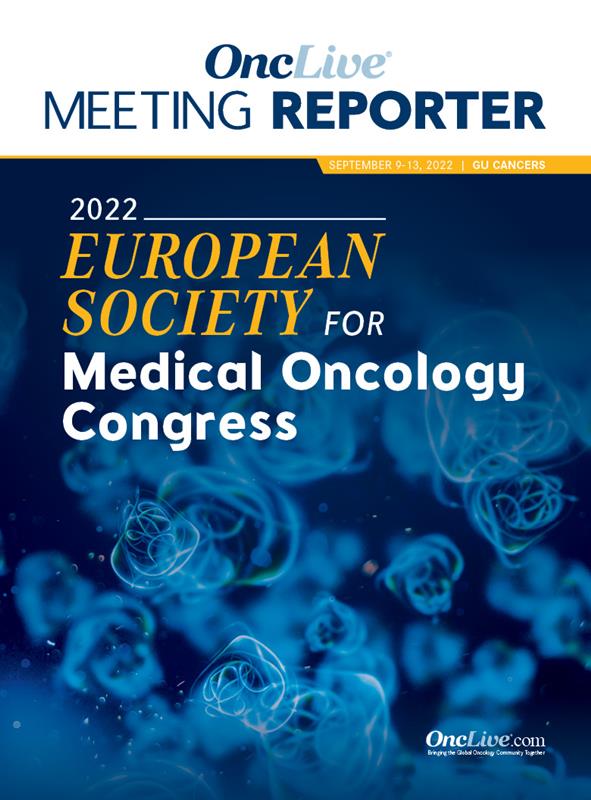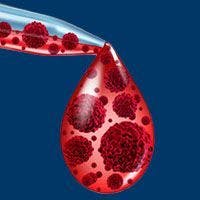Publication
Article
Supplements and Featured Publications
Lenvatinib/Pembrolizumab Combo Provides Continued OS, PFS Benefit in Advanced RCC
Author(s):
Lenvatinib plus pembrolizumab showed sustained overall survival and progression-free survival benefit across poor- and intermediate-risk subgroups of patients with advanced renal cell carcinoma.
Kate Young, MD

Lenvatinib (Lenvima) plus pembrolizumab (Keytruda) showed sustained overall survival (OS) and progression-free survival (PFS) benefit across poor- and intermediate-risk subgroups of patients with advanced renal cell carcinoma (RCC), according to updated results from the phase 3 CLEAR trial (NCT02811861) presented at the 2022 ESMO Congress.1
At a median follow-up of approximately 33 months, a 28% reduction in the risk of death was seen with lenvatinib plus pembrolizumab compared with sunitinib (HR, 0.72; 95% CI, 0.55-0.93). The 24-month OS rate with the combination was 80.2% (95% CI, 75.5%-84.1%) compared with 69.7% (95% CI, 64.4%-74.3%) for sunitinib. Median OS was not estimable for either treatment. Median PFS was 23.3 months (95% CI, 20.8-27.7) with the combination vs 9.2 months (95% CI, 6.0-11.0) with sunitinib (HR, 0.42; 95% CI, 0.34-0.52).
“These data clearly show that the efficacy benefit observed at the primary analysis was robust and maintained with longer follow-up, once again supporting lenvatinib and pembrolizumab as a standard of care in first-line advanced RCC,” lead author Camillo G. Porta, MD, Interdisciplinary Department of Medicine, University of Bari Aldo Moro, said during a presentation of the data. “With longer follow up, at around 33 months, lenvatinib and pembrolizumab continued to show a clinically meaningful benefit in PFS, OS, and ORR vs sunitinib, consistent with primary analysis.”
In the 3-arm study, patients were evenly randomized to receive lenvatinib at 20 mg orally per day plus intravenous pembrolizumab at 200 mg every 3 weeks (n = 355), lenvatinib at 18 mg per day plus oral everolimus at 5 mg per day (n = 357), or oral sunitinib at 50 mg per day for 4 weeks on and 2 weeks off (n = 357). Updated findings for the everolimus arm were not presented at the ESMO meeting.
In the combination arm, the median age of patients was 64 years with 54.6% less than age 65. In the sunitinib group, the median age was 61 years and 63% of patients were below the age of 65. MSKCC prognostic risk was similar between arms. In the combination arm, 27% of patients had favorable risk, 63.9% had intermediate, and 9% had poor risk disease. By IMDC, 59.2% had intermediate risk, 31% favorable, 9.3% poor, and 0.6% could not be evaluated. The PD-L1 combined positive score was ≥1 for a third of patients and <1 for a third of patients. It was not available for the remaining patients. The most common site of metastases was the lung (70.1%) and nearly three-fourths had received a prior nephrectomy.
The objective response rate (ORR) was 71% with lenvatinib plus pembrolizumab (95% CI, 66.3%-75.7%) compared with 36.1% (95% CI, 31.2%-41.1%) for sunitinib (relative risk, 1.97; 95% CI, 1.69-2.29). The rate of complete responses was 17.2% with the combination compared with 4.2% for sunitinib. The median duration of response was 26.0 months (95% CI, 22.2-41.4) with lenvatinib/pembrolizumab compared with 14.7 months (95% CI, 9.4-16.8) with sunitinib.
Initial findings from the study were published in the New England Journal of Medicine.2 At this point the median follow-up was 26.6 months and the hazard ratio for OS was 0.66 favoring lenvatinib and pembrolizumab (95% CI, 0.49-0.88; P = .005). The median PFS was 23.9 vs 9.2 months, for the combination and sunitinib, respectively (HR, 0.39 95% CI, 0.52-0.80; P <.001).
The most dramatic differences between the 2 data sets were seen in the complete response rates, which increased from 16.1% in the initial presentation to 17.2% at the update. “These are the highest complete responses ever observed have seen in kidney cancer,” Porta said.
The PFS hazard ratio (HR) for lenvatinib plus pembrolizumab vs sunitinib was reported by risk group. By MSKCC criteria, the HRs were 0.18 (95% CI, 0.08-0.42), 0.46 (95% CI, 0.35-0.60), and 0.43 (95% CI, 0.29-0.64) for those with poor, intermediate, and favorable risk, respectively. By IMDC criteria, the HRs were 0.30 (95% CI, 0.14-0.62), 0.41 (95% CI, 0.30-0.54), and 0.47 (95% CI, 0.32-0.69), respectively.
The OS HRs were also described by risk criteria for the combination vs single agent. By MSKCC criteria, the OS HRs were 0.50 (95% CI, 0.25-1.02), 0.71 (95% CI, 0.52-0.97), and 1.00 (95% CI, 0.51-1.96) for poor, intermediate, and favorable risk, respectively. By IMDC criteria, the HRs were 0.39 (95% CI, 0.20-0.77), 0.72 (95% CI, 0.52-1.00), and 1.22 (95% CI, 0.55-2.26).
“PFS for patients across all MSKCC and IMDC risk groups and OS for patients across poor and intermediate risk groups favored lenvatinib and pembrolizumab,” Porta noted. “Medians for favorable risk groups were not reached. There were too few events in these groups to form conclusions.”
After 2 years, 101 of 355 patients stopped treatment with pembrolizumab and continued on single-agent lenvatinib alone. In this group, the OS rate at 36 months was 94.5%. Patients who completed 2 years of pembrolizumab had a similar disease risk as the full study population, with 65 having IMDC intermediate or poor risk disease and 36 having favorable risk.
Invited discussant Kate Young, MD, noted that in the absence of head-to-head data that outcomes with the combination of lenvatinib and pembrolizumab looked "slightly better" than other frontline options for RCC, making it an appealing choice. Although, she cautioned against cross trial comparisons.
“Outcome data continues to show clinically meaningful benefit in PFS, OS, and ORR supporting lenvatinib and pembrolizumab as a first-line treatment option in clear cell RCC for all risk groups,” said Young, Locum Medical Oncology Consultant (Renal/Melanoma) at The Royal Marsden NHS Foundation Trust. “The depth of response remains impressive, and this is another good first-line option.”
In August 2021, based on the earlier data from the CLEAR study, the FDA approved the combination of lenvatinib and pembrolizumab as a first-line therapy for patients with advanced RCC.3
References
- Porta CG, Eto M, Motzer RJ, et al. Updated efficacy of lenvatinib (LEN) + pembrolizumab (PEMBRO) vs sunitinib (SUN) in patients (pts) with advanced renal cell carcinoma (aRCC) in the CLEAR study. Ann Oncol. 2022;33(suppl 7).DOI:10.1016/j.annonc.2022.07.1552.
- Motzer RJ, Alekseev B, Rha S-Y, et al. Lenvatinib plus Pembrolizumab or Everolimus for Advanced Renal Cell Carcinoma. N Engl J Med. 2021; 384:1289-1300. DOI: 10.1056/NEJMoa2035716.
- FDA approves lenvatinib plus pembrolizumab for advanced renal cell carcinoma. News Release. FDA. August 11, 2021. Accessed September 11, 2022. https://bit.ly/3B5MvGA
































%20(2)%201-Recovered-Recovered-Recovered-Recovered-Recovered-Recovered-Recovered-Recovered-Recovered-Recovered-Recovered-Recovered-Recovered-Recovered-Recovered-Recovered-Recovered.jpg?fit=crop&auto=format)
%20(2)%201-Recovered-Recovered-Recovered-Recovered-Recovered-Recovered-Recovered-Recovered-Recovered-Recovered-Recovered-Recovered-Recovered-Recovered-Recovered-Recovered-Recovered.jpg?fit=crop&auto=format)
